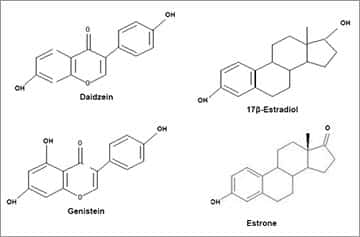




Today, extracts from the root of Pueraria mirifica are claimed by mainstream medical researchers, medical physicians and herbalists as a “fountain of youth” that manifest properties which contribute to rejuvenescence – firmer breasts, hair re-growth, strengthening and darkening of existing hair, improved complexion, amelioration of fine lines and wrinkles in the skin, improved eye health, as well as increased energy and vigor.
Pueraria mirifica is regarded as a “Fountain of youth” because it possesses phytoestrogens that helps supplement estrogen in human body. Although phytoestrogens can also be found in other natural products such as soybeans, bean curd, maca, and even oats and carrots, the phytoestrogens found in Pueraria mirifica are far more effective than those in other plants. Apart from Daidzin, Genistein, and Daidzein that are usually found in soybeans, Pueraria mirifica also contains Miroestrol and deoxymiroestrol which have been shown to have 3,000 times the estrogenic activity of soy isoflavones.
Pueraria mirifica has estrogenic properties that help rejuvenate the body. Pueraria mirifica is traditionally used orally. The dried roots are finely ground and mixed with other medicinal herbs, packed in capsules and marketed as a food supplement. Formulations, ingredient lists, and the content of each product can vary from one supplier to another. When taken orally, women often notice improvement in skin tone, hair, nails, breast and genital tissue – a kind of reversal of the aging process in those organs.
Pueraria mirifica can also be used topically. With modern extraction technology, the dried roots are extracted and standardized into a powdered extract and a fluid extract. The fluid extract is used in the cosmetics industry in breast creams, eye gels, and skin moisturizers. The powdered extract is used similarly to the traditional method, but has absolute uniformity as a result of the advantage of standardization technique.
Topical uses of Pueraria mirifica include breast creams (to help firm breasts), eye gels (to help reduce crow’s feet, under-eye bags, etc.), body gels (to help reduce wrinkles on applied area), and hair tonic (to darken hair, and strengthen the roots of existing hair.)
It is no wonder that Pueraria mirifica has been claimed by local people and modern day researchers as a “fountain of youth”.
Pueraria mirifica is regarded as a “Fountain of youth” because it possesses phytoestrogens that helps supplement estrogen in human body. Although phytoestrogens can also be found in other natural products such as soybeans and bean curt, phytoestrogens in Pueraria mirifica are far more potent than that in other products. Apart from Daidzin, Genistin, and Daidzein that are usually found in soybeans, Pueraria mirifica also contains Miroestrol and deoxymiroestrol which has been shown to have 3,000 times the estrogenic activity of soy isoflavones.


With the right support, it is possible to grow older while greatly decreasing the deterioration we call aging. It is possible to slow down the aging process and lessen its unwelcome effects with Pueraria mirifica (scientifically known as Pueraria mirifica Airy Shaw et Suvatabandhu.)
Local women and rural communities in Thailand have used Pueraria mirifica (known locally in Thailand as Kwao Kreu Kao [kao=white]) effectively as traditional medicine for well over seven hundred years.
In May 1931, Luang Anusan Suntara published a pamphlet on the subject of the benefits derived from Pueraria mirifica. The main part of the pamphlet describes the different ways of using Pueraria mirifica, and claims of its power to rejuvenate were made; which include:
In 1932, Dr. A Kerr directed public attention to the fact that the tuberous roots of Pueraria mirifica contained a valuable rejuvenating substance. Dr. A Kerr was the first to create international awareness of the rejuvenating qualities of Pueraria mirifica, which subsequently led to the isolation of a highly potent estrogen-like (phytoestrogen) compound and to the classification of the plant as Pueraria mirifica in 1952.
The latest epidemiologic studies show that phytoestrogens do not increase the risk for breast cancer. http://www.ncbi.nlm.nih.gov/pubmed/12602916.
Margaret Ritchie, PhD, a world-renowned expert on phytoestrogens and associated breast cancer research at the University of St. Andrews in Scotland explains that plant phytoestrogens simply cannot act the same way mammalian estrogens do because of their 3 dimensional shape. and the way it binds to the estrogen receptors on cells. They are plant sterols, not mammalian steroids.

